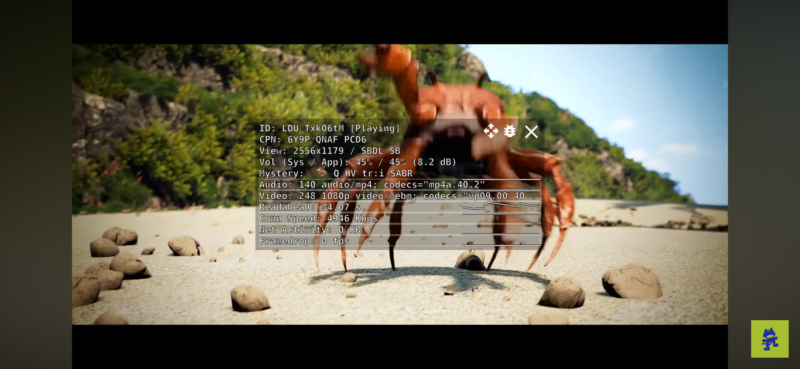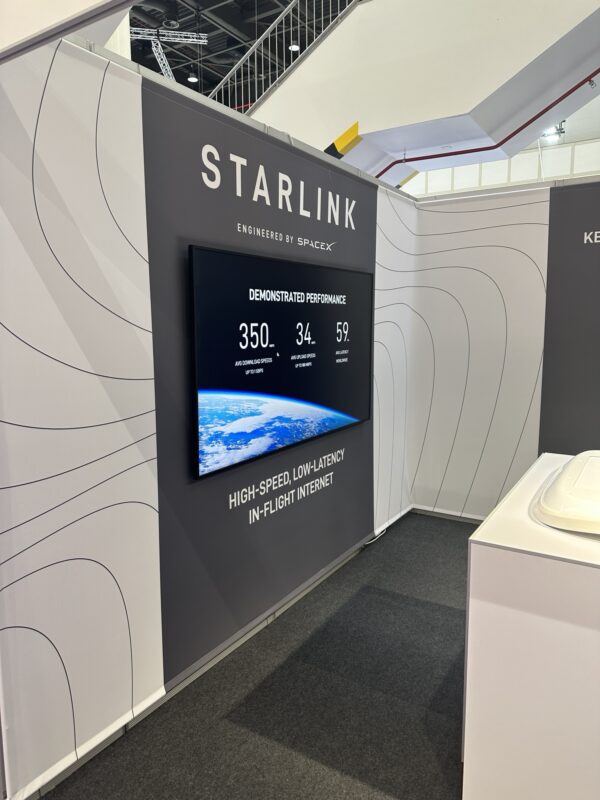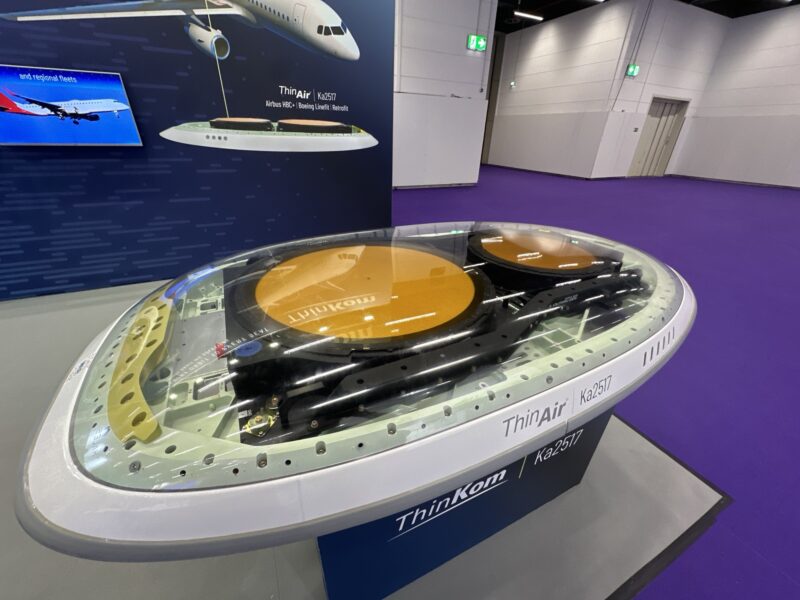Low Earth Orbit (or LEO) Connectivity has been a topic that’s been growing in importance, as satellite providers prepare to offer it beyond the home – and in this case, in the air, as we’ve gone from ground to air testing, and as we head towards real-world deployments.
How does it perform though?
Orbits are everything.
There are three main orbit levels to consider
- LEO – Low Earth Orbit (below an altitude of 2,000 km (1,200 mi)
- MEO – MediumEarth Orbit ( between 2,000 and 35,786 km (1,243 and 22,236 mi))
- GEO – geosynchronous equatorial orbit – 35,786 km (22,236 mi) in altitude
Based on the numbers in Wikipedia.
Most communication satellites live in a Geosynchronous orbit, rather than in Low-Earth or Medium Earth, with some major movement in the past few years in Low-Earth Orbit.
The lower you are, in theory, latency is reduced and speed should improve too.
The Competitors
In the Low-Earth Orbit space, there are two big providers – Oneweb, Starlink (by SpaceX), with Kuiper Systems by Amazon due to join the party in the future.
Demonstrations
Panasonic and Hughes (Utilising the OneWeb network)
Both Panasonic Avionics and Hughes were demonstrating their connectivity solutions in a live environment. Panasonic had mounted an antenna to a ceiling, whilst Hughes had a mobile antenna on a trolly outside the halls of the Hamburg Messe.
As usual, I’ll run my basic battery of tests (that I would do in the air).
They are:
- Connect to Speedtest.net via an app on an iPhone 14Pro
- Connect to YouTube.com
- Render Noisestorm’s Crab Rave – monitoring for dropped frames and video resolution.
- Render Sheet Music Boss’s Rush E – monitoring for dropped frames and general rendering (as the video gets complex, quickly).
To keep things “semi-scientific” these tests were carried out one after the other.
Hughes (over Oneweb)
Hughes showed off their new antenna (marking a change from the previous year, where a test-bench unit was on demonstration. Access to the network was via an SSID and passphrase key.
Running Speedtest, it was speedy for sure, clocking in over 185Mbps, with a more than passable Mbps upload.
The ping speeds are lower than usual – whilst not terrestrial or 5G speed (in a test, I’ve seen between 39 and 84ms pings, it’s better than some airlines I’ve seen, where pings can extend into the thousands of milliseconds).
Moving onto Crab Rave, the rendering was smooth, with YouTube happily delivering 1080p to the phone.
No dropped frames were noted during the test, with it completed in the usual song timespan.
Moving onto Rush E, the playback was smooth, even if it was only being sent over 720p (an uprate from the usual 480p I normally get in an aircraft – showing there is bandwidth to play with).
With a simpler video render like this, I’m looking for image clarity as well as the content being delivered.
Panasonic Avionics (utilising OneWeb)
Panasonic Avionics set their solution up much more as an aircraft portal solution – showing off how it can work when implemented in the sky.
This is actually a better demonstration in some respects, as we get a lot more of the passenger experience impressions.
With it connected – the speeds were a fair bit lower, even though this was connected to the same network in the sky. But it is still very respectable.
This could be put down to many things – be it coverage, angle in the antenna, network overhead and use. I’d consider the speeds offered a win still, with over 100Mbps being offered, even if the ping latency is creeping upwards.
But it’s still better than what’s in the air with traditional GEO providers.
Moving onto Crab Rave, again YouTube managed to send a 1080p stream to the phone, with no frame drops. Frame drops are important – as they can really disjoint a video-watching experience.
If you want to try forcing frame drops, load up the WebGL Aquarium with 1000+ fish, then launch YouTube and watch a video (or try rendering photos and videos at the same time as putting a video on). The experience of the extra load will give you an impression of what it’s like – stutters. Lots of stutters.
That makes for a rather negative viewing experience.
Finally, Rush E appeared. Eventually. The YouTube client was being a pain after being made to do actual work. Again, it was surprising to see this being rendered at 720p, rather than the usual 480p – indicating there was more than a bit of bandwidth to play with.
Starlink
Starlink has finally had aircraft flying with their equipment – notably Hawaiian Airlines are flying it on some of their aircraft, with Qatar Airways to follow. I was going to try to ask about a demonstration, but the Starlink booth was pretty dead for most of the show.
Here are some pretty pictures of an antenna under a ray dome.
As there was no demonstration unit or live demonstration, I could not verify the speed claims. Paxex.aero has tried it live in the field with Hawaiian Airlines, showing off its potential.
Multi Orbit Connectivity could be the real solution
Over the past few years, we’ve seen Multi-Orbit solutions emerge as a solution – these have both an Electrical Steerable Antenna and a more traditional Ka/Ku Annenta. Thinkom (a major provider of antennas) showed off their solution
Airbus also showed off a dual-antenna solution as part of its HBCplus programme
Intelsat was showing off its Electronic Steered Array Antenna, which could operate both LEO and GEO solutions
Multi-antenna systems like this give something important to an airline – flexibility. This allows them to switch from a LEO constellation with high land coverage, but when flying transoceanic, they can switch to a GEO provider to provide the bandwidth – at the cost of latency.
Connectivity in the air isn’t going away soon.
The business case for connectivity in the air has changed over the years – where in the past you might have hopped on to a connection to quickly download an email or message, paid through the nose for slow connectivity for a flight or just idly scrolled websites, we’re seeing changes – be it the use of streaming media, Virtual Private Networks, keeping in contact with network applications and using rich media apps on your phone, so you can look at the latest meme to share, whilst sending a picture of your meal to a friend.
In addition, airlines are using data connectivity streams themselves to handle consumer data – such as processing live payment transactions with credit cards.
That has meant L-Band connectivity solutions have fallen back, with GEO connectivity such as Ku (think Intelsat, Panasonic) and Ka (think Viasat) connectivity coming to the fore offering higher bandwidth, but with high latency.
That makes it unsuitable for applications like online gaming, online conferencing and applications that require an immediate presence and response.
As we delve deeper into the user requirement of high-bandwidth/low-latency, LEO options such as OneWeb and Starlink offer these benefits, as well as paths to integration on an aircraft.
And some operators who are looking for their next-generation solutions will be looking to tick all these boxes – be it from hybrid solutions such as European Aviation Network, using a LEO or GEO network – or many combinations of those deployments.
Disclosures
- Economy Class and Beyond was a guest of Hughes, Panasonic Aerospace, Thinkom, Intelsat and Airbus at Aircraft Interiors Expo.
- Economy Class and Beyond thanks both Hughes and Panasonic Aerospace for access to their demonstration systems
Welcome to Economy Class and Beyond. Your no-nonsense guide to network news, honest reviews, in-depth coverage, unique research, as well as the humour and madness I only know how to deliver.
Our Social Media pool has expanded. You can find us across most networks as @economybeyond on Twitter, Mastodon, BlueSky, Threads and Instagram!
Also, remember that we are part of the BoardingArea community, bringing you the latest frequent flyer news from around the world.




















